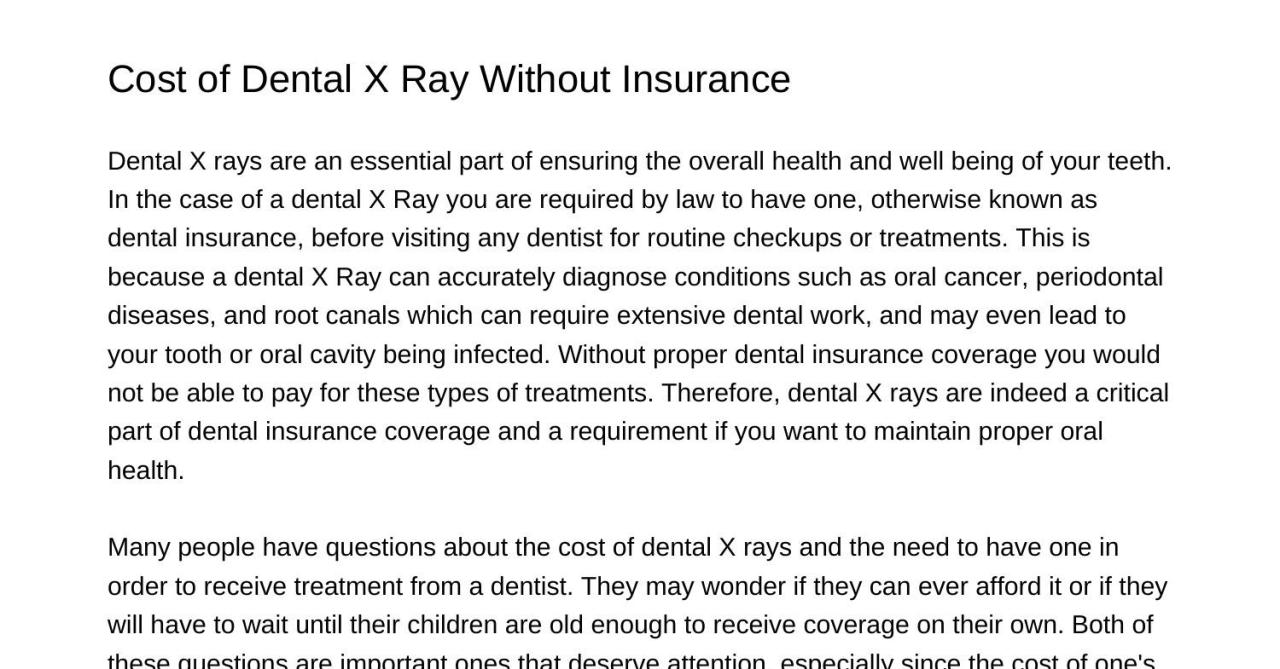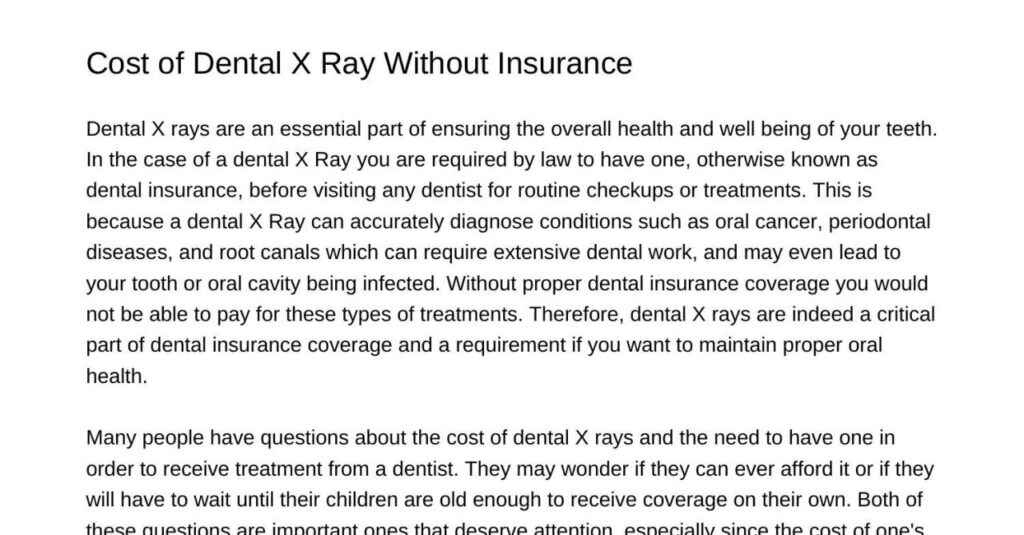Impact of Insurance Status on X-Ray Costs
The presence or absence of health insurance significantly influences the cost of x-rays. Individuals with insurance typically pay less than those without, owing to the coverage provided by their plans.
Insurance plans vary in their coverage for x-rays. Some plans may cover the full cost of the procedure, while others may require co-payments or deductibles. The amount of coverage depends on the specific plan and the individual’s level of coverage.
Factors Affecting Cost Differences
- Negotiated Rates: Insurance companies negotiate discounted rates with healthcare providers, including radiology centers. This allows them to offer lower costs to their members.
- Co-payments and Deductibles: Co-payments are fixed amounts paid by the insured at the time of service. Deductibles are amounts that must be met before insurance coverage begins. These out-of-pocket expenses can increase the cost of x-rays for insured individuals.
- Coverage Limitations: Some insurance plans may have limitations on the number of x-rays covered per year or may exclude certain types of x-rays. This can result in additional costs for insured individuals.
Example Insurance Coverage
- Plan A: Covers 100% of the cost of x-rays up to $100 per year.
- Plan B: Requires a $20 co-payment for each x-ray, with a deductible of $50.
- Plan C: Excludes coverage for x-rays related to pre-existing conditions.
Factors Influencing X-Ray Costs
The cost of an x-ray can vary significantly depending on several factors. These include the type of facility where the x-ray is performed, the location of the facility, and the technology used.
Facility Type
The type of facility where an x-ray is performed can have a significant impact on the cost. X-rays performed at hospitals are typically more expensive than those performed at clinics or imaging centers. This is because hospitals have higher overhead costs, such as the cost of maintaining a large staff and operating a complex facility.
Location
The location of the facility can also affect the cost of an x-ray. X-rays performed in urban areas are typically more expensive than those performed in rural areas. This is because the cost of living is higher in urban areas, which drives up the cost of providing healthcare services.
Technology
The technology used to perform an x-ray can also affect the cost. Newer, more advanced technology is typically more expensive than older, less advanced technology. This is because newer technology requires more specialized equipment and training to operate.
| Facility Type | Location | Cost |
|---|---|---|
| Hospital | Urban | $200-$500 |
| Clinic | Urban | $100-$250 |
| Imaging Center | Urban | $75-$150 |
| Hospital | Rural | $150-$300 |
| Clinic | Rural | $75-$150 |
| Imaging Center | Rural | $50-$100 |
Methods for Reducing X-Ray Costs

Understanding the cost of x-rays without insurance is crucial. Fortunately, there are several strategies you can employ to minimize these expenses.
Negotiating with Providers
* Contact the x-ray facility directly and inquire about possible discounts or payment plans.
* Explain your financial situation and request a reduction in the standard charges.
* Consider asking for a bundled price if you require multiple x-rays.
Utilizing Generic Facilities
* Opt for generic or independent x-ray clinics instead of hospitals or specialized centers.
* These facilities often have lower overhead costs and pass on the savings to patients.
* Check online reviews and ask for recommendations to ensure the quality of service.
Seeking Financial Assistance
* Explore government-sponsored programs that provide financial aid for medical expenses.
* Contact local charities or non-profit organizations that offer assistance with healthcare costs.
* Inquire about payment assistance programs offered by the x-ray facility itself.
Comparison of X-Ray Costs Across Different Providers
The cost of an x-ray can vary significantly depending on the provider. This variation can be attributed to a number of factors, including the type of x-ray, the geographic location of the provider, and the provider’s overhead costs.
To illustrate the cost differences, consider the following table:
| Provider | Chest X-Ray | Pelvic X-Ray |
|---|---|---|
| Hospital A | $200 | $300 |
| Imaging Center B | $150 | $250 |
| Urgent Care Clinic C | $120 | $200 |
As the table shows, the cost of a chest x-ray can range from $120 to $200, while the cost of a pelvic x-ray can range from $200 to $300. The cost differences between providers can be substantial, so it is important to compare prices before choosing a provider.
Factors Contributing to Cost Differences
There are a number of factors that can contribute to the cost differences between providers. These factors include:
- The type of x-ray
- The geographic location of the provider
- The provider’s overhead costs
The type of x-ray is a major factor in determining the cost. More complex x-rays, such as CT scans and MRIs, are more expensive than simpler x-rays, such as chest x-rays and pelvic x-rays.
The geographic location of the provider can also affect the cost of an x-ray. Providers in urban areas tend to have higher overhead costs than providers in rural areas. This is because urban areas have higher costs for rent, utilities, and other expenses.
The provider’s overhead costs can also affect the cost of an x-ray. Providers with higher overhead costs will need to charge more for their services in order to cover their expenses.
Implications for Patients
The cost variations between providers can have a significant impact on patients. Patients who are uninsured or underinsured may have difficulty affording the cost of an x-ray. This can lead to delays in diagnosis and treatment, which can have serious consequences.
It is important for patients to be aware of the cost differences between providers before choosing a provider. Patients can use online resources to compare prices and find the most affordable provider.







